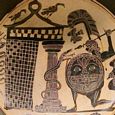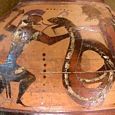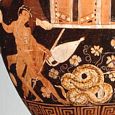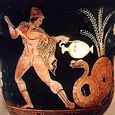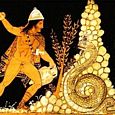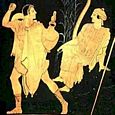DRAKON ISMENIOS
Greek Name
Δρακων Ισμενιος
Transliteration
Drakôn Ismenios
Latin Name
Draco Ismeneum
Translation
Dragon of Ismenus
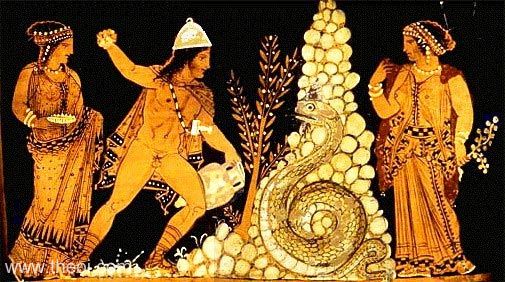
THE DRAKON ISMENIOS (Ismenian dragon) was a giant serpent which guarded the sacred spring of Ares near Thebes. When the hero Kadmos (Cadmus) arrived seeking to found the city, he slew the monster with a heavy stone. The goddess Athena then instructed him to sow the dragon's teeth, producing a crop of fully-grown, armed warriors called Spartoi (Sparti), five of which became the ancestral lords of Thebes. Ares later avenged his draconic son by transforming Kadmos and his wife into serpents.
FAMILY OF THE DRAGON
PARENTS
ARES (Apollodorus 3.22, Hyginus Fab. 178, Ovid Met. 3.874, Nonnus Dionysiaca 4.352)
OFFSPRING
THE SPARTOI (sown from its teeth) (Apollodorus 3.22, Pausanias 9.10.1, Apollonius Rhodius 3.1179f, Hyginus Fab 178, Ovid Met. 3.874, Nonnus Dionys. 4.352)
ENCYCLOPEDIA
ISMENIAN DRAGON. Cadmus built Thebes, with the acropolis, Cadmea. As he intended to sacrifice the cow here to Athena, he sent some persons to the neighbouring well of Ares to fetch water. This well was guarded by a dragon, a son of Ares, who killed the men sent by Cadmus. Hereupon, Cadmus slew the dragon, and, on the advice of Athena, sowed the teeth of the monster, out of which armed men grew up, who slew each other, with the exception of five, Echion, Udaeus, Chthonius, Hyperenor, and Pelor, who, according to the Theban legend, were the ancestors of the Thebans. Cadmus was punished for having slain the dragon by being obliged to serve for a certain period of time, some say one year, others eight years. After this Athena assigned to him the government of Thebes, and Zeus gave him Harmonia for his wife. This is the account given by Apollodorus (iii. 1. § 1, &c.), which, with the exception of some particulars, agrees with the stories in Hyginus (Fab. 178) and Pausanias (ix. 5. § 1, 10. § 1, 12. § 1,&c.)
Source: Dictionary of Greek and Roman Biography and Mythology.
ALTERNATE NAMES
Greek Name
Δρακων Αιωνιος
Transliteration
Drakôn Aiônios
Latin Spelling
Draco Aeoneum
Translation
Dragon of Aeonia
CLASSICAL LITERATURE QUOTES
CADMUS, THE ISMENIAN DRAGON & THE SOWING OF THE TEETH
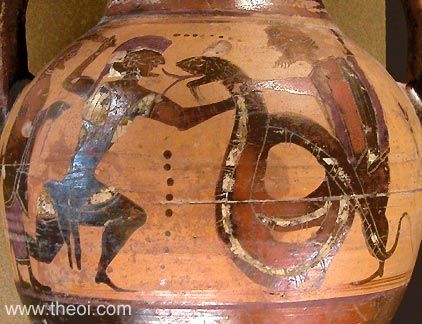
Pseudo-Apollodorus, Bibliotheca 3. 22 (trans. Aldrich) (Greek mythographer C2nd A.D.) :
"[Kadmos (Cadmus)] sent some of his men to fetch water from the spring of Ares, but a Serpent, said by many to be a child of Ares, guarded the spring and destroyed most of those who had been sent. In outrage Kadmos killed the Serpent, and then, following the instructions of Athena, planted its teeth. From this sowing there sprang from the earth armed men, called Spartoi (Sparti). These proceeded to kill each other, some in voluntary encounters, and others in ignorance. Pherelydes [Greek mythographer C5th B.C.] says that when Kadmos saw the armed men growing up from the earth, he threw stones at them, and they, believing that they were being hit by each other, started their fight . . . As for Kadmos, to atone for the deaths he served Ares as a laborer for an 'everlasting' year, for a year then was equal to eight years now."
Apollonius Rhodius, Argonautica 3. 1179 ff (trans. Rieu) (Greek epic C3rd B.C.) :
"He [Aeetes] handed them [Iason (Jason) and Aethalides] the deadly teeth that Iason was to sow. The teeth were those of the Aonian serpent [i.e. the Ismenian Drakon], the guardian of Ares' spring, which Kadmos (Cadmus) killed in Ogygian Thebes. He had come there in his search for Europa, and there he settled, under the guidance of a heifer picked out for him by Apollon in an oracle. Athene, Lady of Trito, tore the teeth out of the serpent's jaws and divided them between Aeetes and Kadmos, the slayer of the beast. Kadmos sowed them in the Aonian [Theban] plain and founded an earthborn clan with all who had escaped the spear of Ares when he did his harvesting."
Pausanias, Description of Greece 9. 10. 1 (trans. Jones) (Greek travelogue C2nd A.D.) :
"Not far from the gate [of Thebes, Boiotia] . . . they show a place where, it is said, Kadmos (Cadmus) sowed the teeth of the Drakon (Dragon), which he slew at the fountain, from which teeth men came up out of the earth."
Pausanias, Description of Greece 9. 10. 5 :
"Higher up [the Ismenian hill outside Thebes in Boiotia] you may see the fountain which they say is sacred to Ares, and they add that a Drakon (Dragon) was posted by Ares as sentry over the spring."
Pseudo-Hyginus, Fabulae 6 (trans. Grant) (Roman mythographer C2nd A.D.) :
"Cadmus, son of Agenor and Argiope, along with Harmonia his wife, daughter of Venus [Aphrodite] and Mars [Ares], after their children had been killed, were turned into snakes in the region of Illyria by the wrath of Mars, because Cadmus had slain the Draco (Dragon), guardian of the fountain of Castalia."
Pseudo-Hyginus, Fabulae 178 :
"While seeking water he [Kadmos (Cadmus)] came to the fountain of Castalia, which a Draco (Dragon), the offspring of Mars [Ares], was guarding. It killed the comrades of Cadmus, but was killed by Cadmus with a stone. Under Minerva's [Athena's] instructions he sowed the teeth and plowed them under. From them sprang the Spartoe (Sparti). These fought among themselves, but from them five survived, namely, Chthonius, Udaeus, Hyperenor, Pelorus, and Echion."
Ovid, Metamorphoses 3. 27 ff (trans. Melville) (Roman epic C1st B.C. to C1st A.D.) :
"He [Kadmos (Cadmus)] sent his henchmen forth to find a spring of living water for the ritual [upon his arrival in Boiotia (Boeotia)]. There stood an ancient forest undefiled by axe or saw, and in its heart a cave close-veiled in boughs and creepers, with its rocks joined in a shallow arch, and gushing out a wealth of water. Hidden in the cave there dwelt a Snake, a Snake of Mars (Anguis Martius) [Ares]. Its crest shone gleaming gold; its eyes flashed fire; its whole body was big with venom, and between its triple rows of teeth its three-forked tongue flickered.
The Tyrians reached the forest glade on their ill-fated quest and dipped their pales into the water. At the sound the Snake (Serpens) thrust from the cave its long dark head and hissed--a frightful hiss! Their blood ran cold. The pails fell from their hands and, horror-struck, they quaked in shock and terror. Coil by snaky coil the serpent wound its way, and, rearing up, curved in a great arching bow, erect for more than half its length, high in the air. It glared down on the whole wide wood, as huge, if all its size were seen, as in the sky the Snake that separates the two bright Bears (Arcti Geminae). Then in a trice it seized them, some in flight, some set to flight, some fixed too fast in fear for either. Every man of them it slew, with fang that struck or coil that crushed or breath that dealt a putrid blast of poisoned death.
The noonday sun had drawn the shadows small, and the son of Agenor [Cadmus], wondering at his men's delay, followed their tracks, his mail a lion's skin, his arms a javelin and lance that gleamed iron-tipped, his heart worth more than any arms. He reached the glade and saw his murdered men, and high in triumph that enormous foe, its blood-red tongue licking their sorry wounds. ‘My faithful fallen friends!’ he cried, ‘You deaths I'll now avenge or share!’ and lifting high a rock above his head with all his might he hurled the mighty missile, such a blow as shatters towers and soaring battlements. The Snake (Serpens), its scales like armour shielding it, stood fast unscathed; its hard black carapace bounced the blow back; but that hard armour failed to foil the javelin that pierced its spine deep in the midmost coil, with the full length of iron buried in the Snake's (Serpens') side. In agony it twisted back its head to see the wound, and bit the deep-sunk shaft, and straining it from side to side at last wrenched it away--but still the iron stuck fast.
Now to its natural rage new source of rage was added. In its throat the arteries swelled huge; its poison fangs were flecked with foam; its scales scraped rasping on the rocks; its breath like the black blast that stinks from holes of Stygia (Hell), befouled the fetid air. And now it coils in giant spirals, now it towers up tall as a tree, now like a stream in spate after a storm it rushes surging on, and breasts aside the woods that bar its way. Agenorides [Cadmus] steps back; his lion's spoil withstands the onslaught; his long lance's point, thrust forward, keeps the darting fangs at bay. The Snake is frenzied; on the unyielding iron it wastes its wounds and bites the metal point. Then from its venom-laden lips an ooze of blood began and spattered the green grass. The wound was slight, for, shrinking from the thrust, it turned its venom-laden lips an ooze of blood began and spattered the green grass. The wound was slight, for, shrinking from the thrust, it turned its injured neck away and kept the blow from piercing deep and striking home. Agenorides [Cadmus] pressed on and drove the firm-lodged lance deep in the creature's gullet, till an oak blocked its retreat and Snake (Serpens) and oak were nailed together. Burdened by the Snake's weight the tree bent curving down; it's strong trunk groaned beneath the lashings of that writhing tail.
Then as the victor contemplates his foe, his vanquished foe so vast, a sudden voice is heard, its source not readily discerned, but heard for very sure : ‘Why, Son of Agenor, why stare at the Snake (Serpens) you've slain? You too shall be a Snake and stared at.’ For an age he stood rigid, frozen in fear, his hair on end, his colour and his courage drained away. But look, a guardian goddess! Gliding down out of the sky Pallas [Athena] appears and bids him plough the soil and plant the Serpent's teeth, from which a future people should arise. Cadmus obeys, and with his plough's deep share opens wide furrows, then across the soil scatters the teeth, the seed of humankind. The tilth--beyond belief!--began to stir: first from the furrows points of spears were seen, next helmets, bright with nodding painted plumes, then shoulders, chests and weapon-laden arms arose, a growing crop of men in mail. So, when the curtain at a theatre is raised, figures rise up, their faces first, then gradually the rest, until at last, drawn slowly, smoothly up, they stand revealed complete, their feet placed on the fringe below.
In fear of these new foemen Cadmus sprang to arms. ‘Lay down your arms!’ a warrior cried, one of the Earth-born (Terrigenae) regiment, ‘Take no part in civil strife.’ So saying, with his sword he felled a Soil-sprung (Terrigenis) brother by his side, then fell himself, struck by a far-flung lance. He too who dealt him death was dead as soon and of that new-given lifebreath breathed his last. In the same mould of madness all that host, that sudden brotherhood, in battle joined, with wound for wound fell dead. That prime of youth, whose lot was life so short, lay writhing on their mother's bloodstained bosom--all save five [the Spartoi (Sparti)], five who survived. Among them was Echion, who at Tritonis' [Athena's] bidding dropped his arms and joined his brothers in a pact of peace. These were his comrades when the Prince of Sidon, obedient to the oracle's command, founded his city in that foreign land."
Ovid, Metamorphoses 3. 545 ff :
"[The Spartoi (Sparti) :] Race of Mars (Proles Marvotia), you Children of the Serpent (Anguigenae) . . . Recall your lineage, brace your courage with the spirit of that Snake (Serpens) who killed, alone, so many. For his pool and spring he died. You, for your honour, you must fight and win! He did brave men to death."
Ovid, Metamorphoses 4. 565 :
"Cadmus . . . overcome by sorrow and his train of troubles and so many warning signs, he left the city, Thebae (Thebes), that he had founded, as if that city's fortune, not his own, were crushing him, and with his pilgrim wife [Harmonia], after long wanderings reached Illyria. And now, worn by their woes and weight of years, the two were talking of their early times, the fortune of their house and their said toils, and Cadmus said ‘Was that a sacred Snake my spear transfixed when I had made my way from Sidon's walls and scattered on the soil the Serpent's teeth, those seeds of magic power? If it is he the jealous gods avenge with wrath so surely aimed, I pray that I may be a Snake and stretch along the ground.’ Even as he spoke he was a snake that stretched along the ground [i.e. He was turned into a snake by Ares as punishment for the slaying of the Drakon.]"
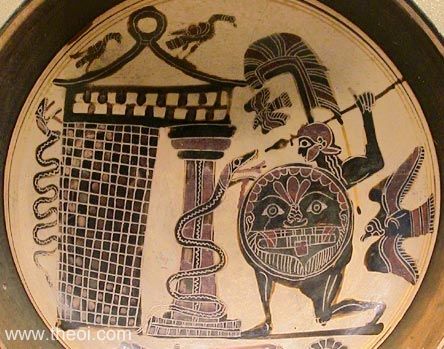
Seneca, Oedipus 725 ff (trans. Miller) (Roman tragedy C1st A.D.) :
"Our land [Thebes] has e'er produced strange monsters : either a serpent [the Ismenian Drakon], rising from the valley's depths, hisses on high above the ancient oaks and overtops the pines; ever higher, above the Chaonian trees he lefts his dark-blue head, although his greater part still lies upon the ground; or else the earth, teeming with impious birth, brings forth armed men [the Spartoi (Sparti)] : loud resounding the battle-call from the curving horn, and the brazen trumpet sent forth its piercing notes. Their tongues and lips, ne'er nimble before, were first employed in the battle-cry of their unfamiliar voice. The kindred bands filled the plains, and this offspring, worthy the seed [i.e. the drakon's teeth] that had been sown, measured their life by a single day; born after the passing of Lucifer [Eosphoros, the dawn star], they perished ere Hesperus [the evening star] arose. The wanderer [Kadmos (Cadmus)] quaked at prodigies so strange, and fearfully awaited the assault of the new-born folk; until the savage youth fell in death, and their mother [the earth] beheld the children she had but now brought forth returned to her own bosom."
Statius, Thebaid 10. 806 (trans. Mozley) (Roman epic C1st A.D.) :
"Verily 'tis the Snake of Mars [Ares], and the ground that burgeoned fresh with our armed sires [the Spartoi (Sparti)]--thence comes that desperate valour [displayed by their descendants], that o'er-mastering love of war."
Nonnus, Dionysiaca 2. 670 ff (trans. Rouse) (Greek epic C5th A.D.) :
"[Zeus addresses Kadmos (Cadmus) :] ‘If you wish to cross life's ferry on a calm sea, escaping the uncertain currents of chance, be careful always not to offend Ares Dirkaian [of the spring of Dirke (Dirce)], Ares angry when deprived of his brood [i.e. the Ismenian Drakon].’"
Nonnus, Dionysiaca 4. 352 - 5. 6 :
"Kadmos (Cadmus) [when founding the city of Thebes] brought the sacred cow beside an altar smoking with incense, and sought a rill of spring water, that he might cleanse his ministering hands and pour the pure water over the sacrifice; for as yet there were no wineplanted gardens to show the delicate fruit of their ripening crop.
He stayed his feet beside drakon-breeding Dirke (Dirce) [the spring of Thebes] : and stood amazed when he saw the speckle-backed Serpent, Ares' child, appear from one side and girdle the spring with snaky coil. The Serpent scared away the great company who followed Kadmos, biting one under the chest with his flashing jaws, rending another with a stroke of bloody tooth, tearing another's life-saving liver when he showed fight and laying him dead : a rough mane slipping out of the dank head ran down disorderly over his neck. Another he scared leaping above the man's temples, ran up another's chin irresistible to strike his eye with poison-shooting dew, and darkened the sparkling gleam of the closing orb. One he caught by the foot and held it in his jaws, tearing it with his bite--spat out green foam from his teeth upon the lad's body, and the greenish poison froze the body livid like steel. Another panted under the strokes of the jaws, and the membranes of the brain billowed throbbing out of the head at the poisonous bite, while a stream of matter ran down through the drenching nostrils out of the melting brain.
Then quickly the Drakon (Dragon) curled round Kadmos, creeping up his legs, and bound him in dangerous bonds; then raising his body high above him with a mounting lurch of his limbs, darted at the round midnipple of the oxhide shield. The man with his legs enclosed by those slanting rings was exhausted by the heavy weight of the long trailing Snake--a horrible burden! But the wearied bearer still stood upright, until the serpent dragged him to the ground and opened his cruel mouth--the monster gaped, and the bloody portal of his raw-ravening throat yawned wide: he turned his head sideways, and with shaking hood curved is neck backwards stretched high over the middle of his coils.
But when Kadmos was nearly exhausted, Athena came near, shaking the aegis-cape with the Gorgon's head and snaky hair, the forecast of coming victory; and the nation-mustering deity cried aloud to the dumbfounded man--‘Kadmos, helpmate and ally of Zeus Gigante-Slayer in the battle! Are you afraid when you see only one snake? In those battles Kronion (Cronion) trusted in you, and brought low Typhon with all that shock of heads, and every one a snake! Tremble no more at the hiss from the creature's teeth. Pallas bids you on! Brazen Ares shall not save his reptile guardian beside murderous Dirke. But when he is killed, take the creature's horrible teeth, sow the ground all about with the snaky corn, reap the viperous harvest of warrior giants, join the battalions of the Gegenees (Earthborn) in once common destruction, and leave only five living: let the crop of the Sown sprout up to glorious fruitage for Thebes that shall be.’
With these words Athene encouraged the discomfited Kadmos, and then she cleft the aery deeps with windswift foot, until she entered the house of Zeus. But Kadmos where he stood on the dry earth lifted a well-rounded boundary-stone of the broad farm-land, a rocky missile! And with a straight cast of the stone smashed the top of the Drakon's head; then drawing a whetted knife from his thigh he cut through the monster's neck. The hood severed from the body lay apart, but the tail still moved, rolling in the dust until it had uncoiled again its familiar rings. There lay the Drakon stretched on the ground, dead, and over the corpse furious Ares shouted in heavy anger. By his wrath Kadmos was destined to change his limbs for a curling shape [i.e. he was turned into a snake by Ares], and to have a strange aspect of Drakon's countenance at the ends of the Illyrian country [i.e. a land he ruled in his old age].
But that was ordained for long after. Now he gathered the fruit of death inside a helmet of bronze, the grim harvest of the creature's jaws. Then he drew upon the land the humped plow of Pallas [Athene] from her holy place in those parts, and plowed a battle-breeding furrow in the bright earth and sowed long lines of the poison-casting teeth. There grew out the self-delivered crop of Gigantes (Earth-Born): one shot up with head high, shaking the top of a mailcoated breast; one with jutting head stretched a horrid shoulder over the opening earth; another bent forward above ground as far as the midnipple, one again rose on the ground half-finished and lifted a soil-grown shield; another shook a nodding plume before him and showed not yet his chest; while still creeping up slowly from his mother's flanks he showed fight against fearless Kadmos, clad in the armour he was born in. O what a great miracle! Eileithyia [goddess of childbirth] armed him whom the mother had not yet spawned! And there was one who cast his brother-spear, fumbling and half visible; one who lightly drew the whole body in to the light, but left his toes unfinished sticking in the ground.
Kadmos for all that did not neglect Athena's injunction. He reaped the stubble of Gigantes spring up ever anew. One he struck with windswift spear over the breast, hit one on the broad neck by the collarbone shearing the bones of the hairy throat: another he tore with hurtling stone while he showed as far as the belly. The blood of the dreadful Gigantes flowed in rivers; Ares slipt in the gore staining his limbs with crimson, and Nike's robe was reddened with purple drops while she stood beside the battle. Another showed fight, and Kadmos rang his sword through his cognate shield of oxhide, into the hip-joint and out at the small of his back. The slaughter stayed not: as the Gigantes were cut and smitten with the sword, a deadly spout of bloody dew bubbled up.
Then by the wise counsel of Pallas he lifted a stone high above the Gegenees' (Earth-Born's) heads; and they drunken with gory lust for Enyo, went wild with warlike fury and destroyed each other with the steel their cousin, and found burial in the dust. One fought with another: with ruddy gore the surface of the shield was drenched and spotted and darkened, as a Gegeneos died; the crop of that field was shorn by the brother-murdering blade of an earth-grown knife.
As Kadmos had reaped the snaky crop of toothplanted battles, and shorn the stubble of the Gigantes, pouring the libation to Ares as the firstling feast of harvest-slaughter, he cleansed his body in drakon-breeding Dirke, and sacrificed the Delphian cow on the god-built altar as fair offering for Pallas."
Suidas s.v. Kadmeia nike (trans. Suda On Line) (Byzantine Greek Lexicon C10th A.D.) :
"When Kadmos (Cadmus) destroyed the Drakon (Dragon) which guarded the spring of Ares, he laboured for Ares for eight years."
JASON & THE SOWING OF THE DRAGON'S TEETH
Pseudo-Apollodorus, Bibliotheca 1. 128 - 130 (trans. Aldrich) (Greek mythographer C2nd A.D.) :
"Aeetes ordered him [Iason (Jason)] to yoke them [the fire-breathing bulls] and sow some drakon-teeth which he had received from Athena: they were half of the teeth which Kadmos (Cadmus) had sown in Thebes . . . And she [Medeia] explained to him that when he had sown the drakon-teeth, armed warriors would rise up from the earth to attack him. When he saw them grouped together he was to throw stones in their midst, keeping his distance, and as they were fighting each other over the stones, he was to slay them . . . he sowed the drakon-teeth, and armed men did rise up from the earth. Wherever he saw a quantity of them, he threw stones without their seeing him, and as they fought with each other he moved in and slaughtered them."
Apollonius Rhodius, Argonautica 3. 1179 ff (trans. Rieu) (Greek epic C3rd B.C.) :
"He [Aeetes] handed them [Iason (Jason) and Aethalides] the deadly teeth that Iason was to sow. The teeth were those of the Aonian serpent [i.e. the Ismenian Drakon], the guardian of Ares' spring, which Kadmos (Cadmus) killed in Ogygian Thebes . . . Athene, Lady of Trito, tore the teeth out of the serpent's jaws and divided them between Aeetes and Kadmos, the slayer of the beast. Kadmos sowed them in the Aonian [Theban] plain and founded an earthborn clan with all who had escaped the spear of Ares when he did his harvesting."
ANCIENT GREEK ART
SOURCES
GREEK
- Apollodorus, The Library - Greek Mythography C2nd A.D.
- Apollonius Rhodius, The Argonautica - Greek Epic C3rd B.C.
- Pausanias, Description of Greece - Greek Travelogue C2nd A.D.
- Nonnus, Dionysiaca - Greek Epic C5th A.D.
ROMAN
- Hyginus, Fabulae - Latin Mythography C2nd A.D.
- Ovid, Metamorphoses - Latin Epic C1st B.C. - C1st A.D.
- Seneca, Oedipus - Latin Tragedy C1st A.D.
- Statius, Thebaid - Latin Epic C1st A.D.
BYZANTINE
- Suidas, The Suda - Byzantine Greek Lexicon C10th A.D.
BIBLIOGRAPHY
A complete bibliography of the translations quoted on this page.
